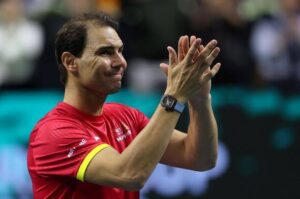Tennis legend Rafael Nadal has once again shown that his greatness extends far beyond the court. In a remarkable act of generosity, the 22-time Grand Slam champion has donated \$12.5 million to fund the construction of a cutting-edge tennis stadium designed to nurture and inspire the next generation of tennis talent. The new facility, set to be located in his hometown of Manacor, Mallorca, aims to become a global hub for youth development in tennis and sport.

Nadal, known for his unmatched work ethic, humility, and sportsmanship, is no stranger to philanthropic efforts. Through his Rafa Nadal Foundation, he has long championed educational and athletic opportunities for underprivileged children. However, this latest donation marks one of his most ambitious and lasting contributions to the sport that has defined his life.
The planned stadium will feature a 10,000-seat arena equipped with the latest in sports technology, training centers, medical facilities, and eco-friendly infrastructure. It will serve as the centerpiece of an expanded Rafa Nadal Academy campus, further elevating the already world-renowned institution. Construction is expected to begin later this year, with completion projected for 2027.
“This is not just about tennis,” Nadal said during the announcement ceremony. “It’s about giving young people the tools to grow, to work hard, and to dream big. I have been so fortunate in my life and career, and I want to give back in a way that creates lasting opportunities.”
The initiative has been widely praised by the tennis community and beyond. Fellow players, coaches, and sports leaders have lauded Nadal for his vision and commitment. Many see this project as a natural extension of his legacy—not just as a champion on the court, but as a role model and leader off it.
Toni Nadal, Rafael’s longtime coach and uncle, described the project as “a reflection of Rafael’s values—discipline, respect, and perseverance. This stadium will become a home for those values, where future champions can be molded.”
Beyond serving aspiring professionals, the stadium and its surrounding facilities will be open to local communities and host grassroots events, ensuring accessibility and inclusion. Special programs will target underprivileged youth and children with disabilities, staying true to the foundation’s mission of social impact through sport.
Environmental sustainability is also central to the project. The stadium is being designed with solar energy systems, water recycling technologies, and minimal environmental footprint, aligning with broader efforts to combat climate change and promote responsible development in sports infrastructure.
Sports analysts and fans alike have drawn comparisons between this initiative and similar legacy-building projects by icons such as Roger Federer and Serena Williams. Yet Nadal’s vision stands out for its scale, local roots, and holistic approach to development.

“Rafa has always talked about the importance of hard work and humility,” said Carlos Moyá, former world No. 1 and current coach. “Now he’s turning those words into bricks and concrete—building something that will last much longer than any trophy.”
For Rafael Nadal, whose career has inspired millions, this latest move cements his status as not only one of the greatest athletes of all time but also one of its most compassionate and visionary. As the stadium begins to take shape in the coming years, its foundations will be rooted not only in stone, but in kindness, legacy, and the enduring spirit of giving back.
With this act of generosity, Nadal proves that true champions are defined not just by how they win, but by how they uplift others along the way.
